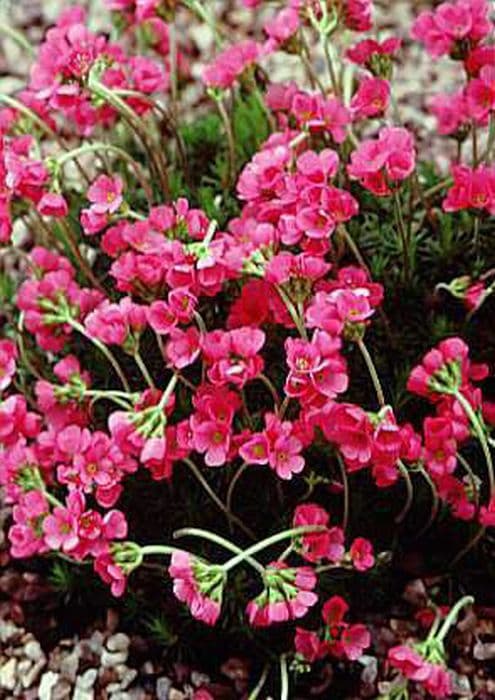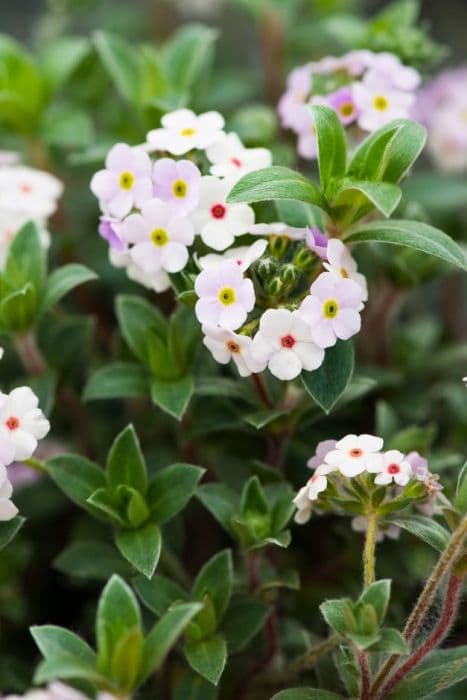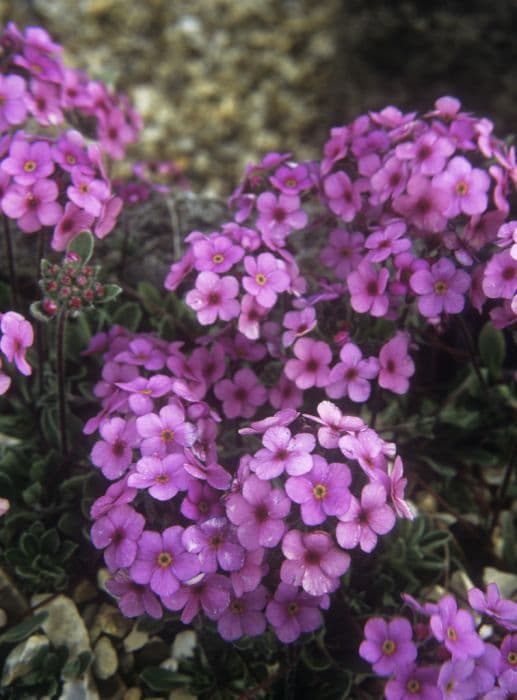Auricula Primula auricula 'Sarah Lodge' (Au/d)

ABOUT
The Primula auricula 'Sarah Lodge' is a captivating plant admired for its strikingly beautiful flowers. Each bloom showcases a unique, round shape that can be described as flat-faced with a soft texture. The petals exhibit a gradient of colors, beginning from a deep, velvety center and transitioning outward to a lighter shade, creating a delightful contrast that draws attention. The central part of the flower, often a darker, rich hue, is surrounded by a lighter, prominent edge or rim, which accentuates the flower's form. The foliage of 'Sarah Lodge' is also attractive, with leaves arranged in a low-growing, rosette pattern. The leaves are typically a lush green color, adding a perfect backdrop to the vibrant flowers. The flowers themselves are usually borne in clusters on upright stems that rise gracefully from the rosette, providing an impressive display when the plant is in full bloom. The overall charm of the Primula auricula 'Sarah Lodge' is enhanced by its dainty appearance, with flowers exuding a softness and sophistication that make it a popular choice for gardeners seeking to add a touch of elegance to their gardens. Despite its delicate looks, this plant is known for its resilience, adding to its appeal for those looking to bring long-lasting beauty to their outdoor spaces.
About this plant
 Names
NamesFamily
Primulaceae.
Synonyms
Bear's Ear Auricula, Mountain Cowslip, Bear's Ear Primrose.
Common names
Primula auricula 'Sarah Lodge'.
 Toxicity
ToxicityTo humans
The Bear's ear, specifically Primula auricula 'Sarah Lodge', is not commonly known for being a toxic plant to humans. However, some people might be sensitive to the plant and can develop dermatitis upon handling it due to the presence of primin, a compound in the plant's sap. If ingested, it is not expected to cause poisoning. It is always advisable to keep plants out of reach of children who might ingest them out of curiosity.
To pets
The Bear's ear, in the form of Primula auricula 'Sarah Lodge', is not generally recognized as a toxic plant to pets. As with humans, some animals might have a sensitivity or allergic reaction to the plant, potentially resulting in mild dermatitis if they come into contact with the sap due to the compound primin. Ingestion is usually not a cause for concern but monitoring your pet for any signs of gastrointestinal upset is recommended. If such symptoms occur, consulting a veterinarian would be prudent.
 Characteristics
CharacteristicsLife cycle
Perennials
Foliage type
Evergreen
Color of leaves
Green
Flower color
Varies
Height
6 inches (15 cm)
Spread
6 inches (15 cm)
Plant type
Herb
Hardiness zones
5
Native area
Europe
Benefits
 General Benefits
General Benefits- Ornamental value: 'Sarah Lodge' is a cultivar known for its attractive flowers, which can add beauty and visual interest to gardens and landscapes.
- Compact size: The plant typically has a small, compact growth habit, making it suitable for smaller gardens or as a border plant.
- Spring blooming: It flowers in spring, providing early season color after the winter months.
- Perennial nature: As a perennial, it will return each year, representing a long-term addition to the garden.
- Variety of colors: Comes in a range of colors, offering the opportunity to add diversity to planting schemes.
- Easy to grow: Generally easy to cultivate and care for, requiring minimal maintenance.
- Attracts pollinators: The flowers are known to attract bees and butterflies, supporting local ecosystems.
- Hybrid vigor: As a cultivar, 'Sarah Lodge' may exhibit hybrid vigor, with increased robustness and flowering over wild types.
- Cold-hardiness: Primula auricula is known to be cold-hardy, making it suitable for cooler climates.
 Medical Properties
Medical PropertiesThis plant is not used for medical purposes.
 Air-purifying Qualities
Air-purifying QualitiesThis plant is not specifically known for air purifying qualities.
 Other Uses
Other Uses- Ornamental display in miniature gardens: The compact size and attractive blooms of auricula make it suitable for creating detailed and colourful miniature garden landscapes.
- Photography subject: Auricula's unique and vivid flower patterns make it a popular subject for photographers, especially those specializing in macro and botanical imagery.
- Edible flower garnishes: The flowers of auricula can be used to add a splash of colour and a mild, lettuce-like flavour to salads and desserts.
- Themed garden collections: Auricula can be included in Shakespearean or historical gardens, as it has been cultivated since the Elizabethan era.
- Floral crafts: The flowers can be used in making pressed flower art, due to their distinct shapes and durability when dried.
- Bee and butterfly gardens: Planting auricula can support local pollinators as they are a nectar source for bees and butterflies.
- Scented gardens: Some auricula varieties are fragrant and can contribute to a sensory garden experience.
- Teaching tool in horticulture: Auricula can be used to educate on plant hybridization and propagation techniques, given their varied hybrids and ease of propagation.
- Plant theatre displays: Auricula fits perfectly in traditional plant theatres, which were popular in Victorian times to display a collection of potted plants.
- Seasonal festivals and competitions: Auricula can be grown and showcased at plant shows and competitions, especially in spring when they bloom.
Interesting Facts
 Feng Shui
Feng ShuiThe Auricula is not used in Feng Shui practice.
 Zodiac Sign Compitability
Zodiac Sign CompitabilityThe Auricula is not used in astrology practice.
 Plant Symbolism
Plant Symbolism- Unique Beauty: The distinctive appearance of the 'Sarah Lodge' type of Auricula with its bold colors and patterns symbolizes uniqueness and the celebration of beauty that stands out from the norm.
- Preciseness: Auriculas are known for their precise, almost artificial appearance, symbolizing an appreciation for accuracy and detail in one's life.
- Hospitality: Historically, Auriculas were often used in Primula shows and shared among gardeners, symbolizing a spirit of community and sharing.
- Boldness: The intense, vibrant colors of the 'Sarah Lodge' Auricula symbolize boldness and the courage to express oneself vividly.
- Perseverance: Auriculas are hardy mountain flowers that can thrive in adverse conditions, symbolizing perseverance and resilience in the face of challenges.
 Water
WaterThe Bear's Ear should be watered when the top inch of soil feels dry to the touch. This often means watering approximately once a week, but frequency can vary depending on environmental conditions like temperature and humidity. When watering, use lukewarm water, adding enough so it runs through the drainage holes, which could mean using about half a gallon for a medium-sized pot. During the active growing season in spring and summer, the plant may require more frequent watering, while in winter, watering can be reduced. Always avoid waterlogging as it can lead to root rot.
 Light
LightBear's Ear thrives in bright, indirect light but can tolerate some partial shade. The best spot for this plant would be near an east or west-facing window where it can receive a few hours of gentle morning or evening sunlight. Direct afternoon sun should be avoided as it can scorch the leaves.
 Temperature
TemperatureBear's Ear prefers cool to moderate temperatures, with ideal conditions ranging between 50°F and 70°F. It can survive at a minimum temperature of 40°F but should be protected from frost. During the flowering period in spring, maintaining the lower end of this temperature range can help prolong the blooms.
 Pruning
PruningBear's Ear requires minimal pruning, mostly to remove dead or faded flowers and to maintain its shape. Deadheading spent flowers encourages further blooming and prevents the plant from expending energy on seed production. Prune the plant after the main bloom, typically in late spring or early summer.
 Cleaning
CleaningAs needed
 Soil
SoilAuricula primrose (Primula auricula 'Sarah Lodge') prefers a well-draining, gritty mix with some organic matter. An ideal soil mixture can be made from one part loam, one part peat-free compost, and one part grit, with added leaf mould. The soil pH should be slightly acidic to neutral, ideally around pH 6.0 to 7.5.
 Repotting
RepottingAuricula primrose should be repotted every one to two years to refresh the soil and accommodate root growth. It's best to repot these plants in late summer after flowering or in early spring before the onset of new growth.
 Humidity & Misting
Humidity & MistingAuricula primrose thrives best in moderate humidity levels, avoiding extremes of dry or overly moist air. Aim for a humidity level around 50% to 60%, which is comfortable for indoor environments and mimics their natural alpine habitat.
 Suitable locations
Suitable locationsIndoor
Place in bright, indirect light with cool temperatures.
Outdoor
Part shade, well-drained soil, protect from hot sun.
Hardiness zone
4-8 USDA
 Life cycle
Life cycleThe Auricula 'Sarah Lodge' (Au/d), commonly known as the Bear's Ear, begins its life cycle as a seed, which upon germination in spring, develops into a small rosette of leaves. As the plant matures, it forms a more substantial rosette and produces a flower stalk with clusters of brightly colored, fragrant flowers, typically blooming in mid to late spring. After pollination by insects, it sets seed that, if not collected, falls to the ground to begin a new generation. During summer, the plant continues to grow vegetatively, strengthening its root system and foliage. As autumn approaches, the Bear's Ear enters a period of dormancy, with growth slowing down as temperatures drop. Throughout winter, it endures the cold weather, sometimes with the protection of mulch, until the next cycle of growth and flowering in the spring.
 Propogation
PropogationPropogation time
Spring-Early Summer
Primula auricula 'Sarah Lodge', commonly known as Auricula Primrose, is typically propagated by division. This method is usually carried out in late summer or early autumn. To propagate by division, carefully lift the plant from the soil and gently separate the clumps into smaller sections, ensuring that each new section has at least one growth bud. Replant the divisions immediately, spacing them about 6 inches (around 15 centimeters) apart to allow ample room for growth. This method not only helps to rejuvenate older plants that may have become woody in the center, but it also creates new plants that will bloom in the following season.









